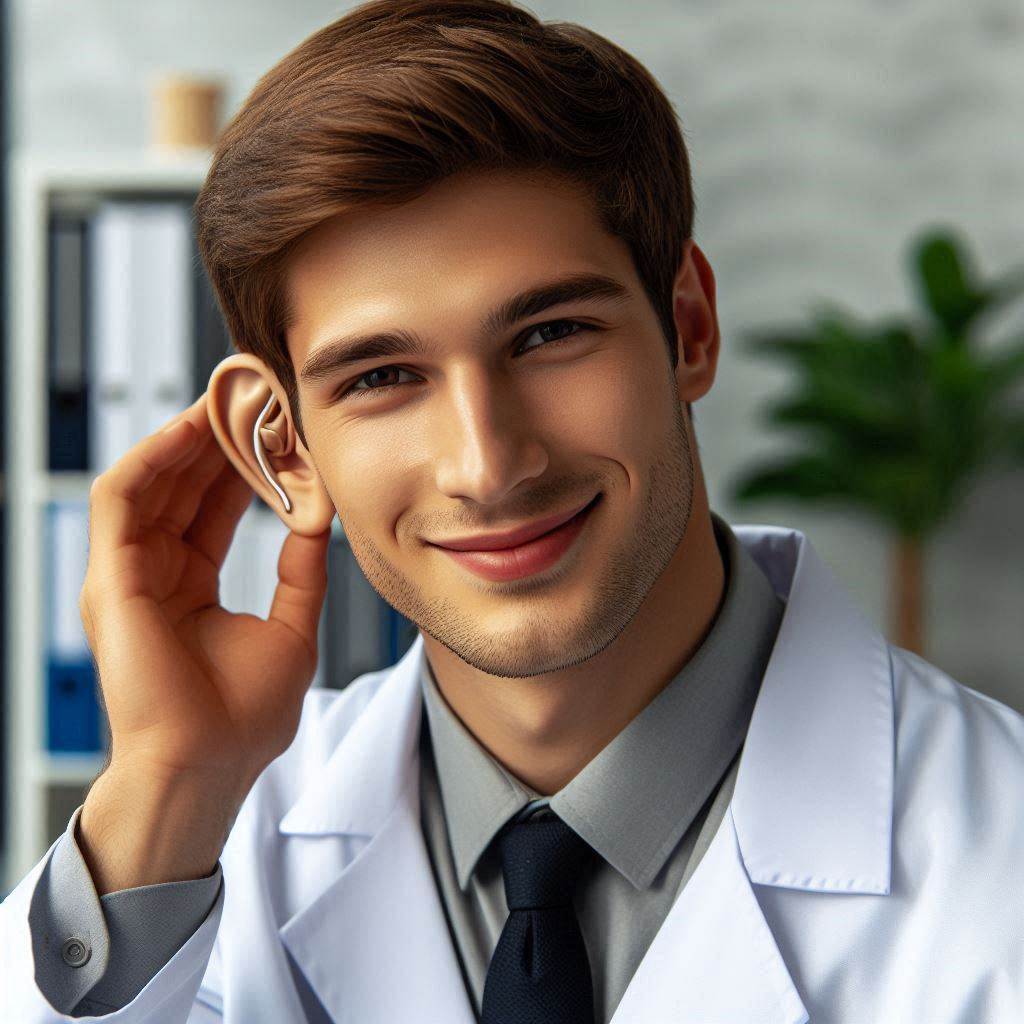Introduction
In this blog post, we will explore Audiology and Hearing Aids Technological Advances.
Audiology and hearing aids have evolved significantly over the past century. Early hearing aids were cumbersome, providing limited amplification and clarity.
As technology advanced, hearing aids became smaller and more effective.
In the early 20th century, vacuum tube technology improved hearing aid performance. Transistor technology in the 1950s led to smaller, more portable devices.
Digital technology revolutionized hearing aids in the 1980s, offering superior sound quality and customization.
Modern hearing aids are highly sophisticated, featuring digital signal processing and wireless connectivity.
These advances have significantly improved the quality of life for individuals with hearing loss.
People can now enjoy clearer sound, easier communication, and enhanced social interactions.
Technological advancements in audiology extend beyond hearing aids.
Cochlear implants, bone-anchored hearing systems, and advanced diagnostic tools have transformed hearing healthcare.
These innovations provide tailored solutions for different types of hearing loss, offering hope and improved outcomes.
Improving hearing aids’ functionality and accessibility remains crucial.
With more advanced technology, we can expect even greater improvements in sound quality, battery life, and user comfort.
These enhancements will further integrate hearing aids into daily life.
The purpose of this blog post is to highlight the significance of technological advances in audiology and hearing aids.
We will explore how these innovations have improved the lives of individuals with hearing loss.
By understanding these advancements, we can appreciate the impact of technology on hearing healthcare.
In essence, technological advances in audiology and hearing aids have greatly enhanced the lives of those with hearing loss.
These innovations continue to push the boundaries of what is possible, offering a brighter future for many.
History of Audiology
Overview of the Early Methods of Diagnosing and Treating Hearing Loss
Early audiology practices relied heavily on basic observational methods. Physicians used rudimentary tools to assess hearing loss.
Transform Your Career Today
Unlock a personalized career strategy that drives real results. Get tailored advice and a roadmap designed just for you.
Start NowSimple hearing tests often involved whispering or clapping. Early hearing aids were large and cumbersome, primarily mechanical or acoustic devices.
Ear trumpets and speaking tubes were common in the 18th and 19th centuries. These devices amplified sound but offered limited benefit.
In the 1920s, vacuum tube hearing aids emerged, marking the beginning of electronic amplification. However, these devices were bulky and impractical.
Despite their limitations, these early methods laid the groundwork for modern audiology.
Transition to Modern Audiology Practices
The mid-20th century marked a significant transition in audiology. World War II spurred advancements due to veterans returning with hearing loss.
The development of audiometers revolutionized hearing assessments, allowing precise measurements.
The creation of the audiogram provided a visual representation of hearing loss. Digital technology in the late 20th century brought further advancements.
Programmable hearing aids emerged, allowing personalized settings for users.
Research into cochlear implants began, offering hope for those with profound hearing loss.
These modern practices significantly improved diagnosis and treatment outcomes.
Impact of Technological Advancements on the Field
Technological advancements have profoundly impacted audiology. Digital hearing aids offer superior sound quality and customization.
Modern devices are small, discreet, and highly effective. Bluetooth connectivity allows seamless integration with smartphones and other devices.
Artificial intelligence has further enhanced hearing aids, offering adaptive sound environments.
Cochlear implants have transformed the lives of individuals with severe hearing loss. Tele-audiology provides remote consultations, increasing access to care.
These advancements have improved the quality of life for countless individuals. The future of audiology looks promising with ongoing technological innovations.
In summary, the history of audiology reflects a journey from rudimentary methods to sophisticated technologies.
Modern advancements continue to revolutionize the field, offering hope and improved quality of life.
Read: The Importance of Audiologists in Pediatric Hearing Care
Technological Advances in Hearing Aids
Digital hearing aids have revolutionized the field of audiology, offering advanced features and customization options for users.
Features of Modern Hearing Aids
- Bluetooth Connectivity: Allows users to stream audio directly from their smartphones or other devices.
- Noise Cancellation: Filters out background noise for improved clarity in conversations and other sounds.
- Rechargeable Batteries: Eliminates the need for constant battery changes and reduces environmental impact.
Benefits of these Advances for Users
- Improved Quality of Life: Digital hearing aids provide better sound quality and speech understanding, enhancing overall communication.
- Enhanced Connectivity: Bluetooth technology enables seamless integration with smartphones and other devices.
- Convenience: Rechargeable batteries make it easier to use hearing aids without worrying about running out of power.
Read: Chiropractic Solutions for Chronic Pain Management
Transform Your Career Today
Unlock a personalized career strategy that drives real results. Get tailored advice and a roadmap designed just for you.
Start NowTele-audiology
Explanation of tele-audiology and its role in increasing access to hearing healthcare
Tele-audiology leverages technology to provide hearing healthcare services remotely. It uses digital tools to bridge gaps in access to audiological care.
This approach connects patients with audiologists regardless of location. It ensures timely interventions for those in rural or underserved areas.
Patients can receive consultations, diagnostics, and follow-ups without traveling long distances.
Tele-audiology also facilitates continuous monitoring and adjustments of hearing aids.
It empowers patients with mobility issues or those who face logistical challenges.
This method enhances convenience and expands the reach of hearing healthcare services.
By reducing barriers, tele-audiology plays a crucial role in improving overall hearing health.
Use of tele-audiology during the COVID-19 pandemic
The COVID-19 pandemic accelerated the adoption of tele-audiology. Social distancing measures necessitated remote healthcare solutions.
Audiologists turned to tele-audiology to continue serving their patients safely. Virtual consultations replaced in-person visits, maintaining essential care.
Remote hearing aid programming ensured devices functioned optimally. Patients appreciated the convenience and safety of tele-audiology during lockdowns.
The pandemic highlighted the viability and effectiveness of remote audiology services.
Tele-audiology allowed uninterrupted care while minimizing the risk of virus transmission.
It showcased the adaptability of hearing healthcare professionals in crisis situations.
The pandemic demonstrated the indispensable role of tele-audiology in modern audiology practice.
Opportunities and challenges of remote audiology services
Tele-audiology offers numerous opportunities for enhancing hearing healthcare. It provides greater accessibility, especially for rural and underserved populations.
Remote services can be more cost-effective for both patients and providers. Patients benefit from reduced travel time and expenses.
Tele-audiology also enables continuous monitoring and timely interventions. However, challenges remain in its widespread adoption.
Not all patients have access to reliable internet or digital devices. Some audiological assessments require specialized equipment not available remotely.
Privacy and data security concerns must be addressed. Additionally, there is a need for training audiologists in telehealth technologies.
Balancing these opportunities and challenges is key to tele-audiology’s success.
Transform Your Career Today
Unlock a personalized career strategy that drives real results. Get tailored advice and a roadmap designed just for you.
Start NowRead: Career Outlook and Job Opportunities for Audiologists

Assistive Listening Devices
Assistive listening devices play a crucial role in improving communication for individuals with hearing loss.
Overview of Assistive Listening Devices
Assistive listening devices come in various forms, including FM systems and captioning services.
FM systems utilize radio waves to transmit audio signals directly to a receiver worn by the individual.
Captioning services provide real-time text display of spoken words during events or presentations.
Enhancing Communication for Individuals with Hearing Loss
Assistive listening devices enhance communication by addressing specific hearing needs and reducing background noise.
They amplify sound selectively, making it easier for individuals to hear speech clearly.
Also. they can be used in diverse settings such as classrooms, meetings, and entertainment venues.
They improve speech understanding and overall communication effectiveness.
Integration of Assistive Listening Devices with Modern Technology
Modern technology has revolutionized assistive listening devices, making them more user-friendly and versatile.
Bluetooth connectivity enables seamless integration with smartphones and other personal devices.
Smartphone apps allow for customization of settings and real-time adjustments based on the user’s preferences.
Wireless connectivity enables synchronization with televisions, computers, and public address systems.
In short, assistive listening devices play a vital role in improving communication and quality of life for individuals with hearing loss.
Their integration with modern technology enhances their functionality and convenience, making them indispensable tools for those with hearing challenges.
Read: A Day in the Life of a Professional Audiologist
Future Trends in Audiology
As technology continues to advance at a rapid pace, the field of audiology is also evolving.
Emerging technologies such as artificial intelligence and wearable devices are set to revolutionize the way we diagnose, treat, and manage hearing loss in the future.
Upcoming Technologies in Audiology
- Artificial Intelligence: AI has the potential to analyze large amounts of data quickly and accurately, leading to more precise diagnoses and personalized treatment plans for individuals with hearing impairments.
- Wearable Devices: From hearing aids to cochlear implants, wearable devices are becoming more sophisticated and discreet, providing users with improved sound quality and connectivity options.
Potential Impact of Advancements
These technological advancements are expected to have a significant impact on the field of audiology:
- Diagnosis: AI-powered algorithms can help audiologists detect hearing issues early on, leading to timely interventions and better outcomes for patients.
- Treatment: Wearable devices with advanced features can dynamically adjust to different listening environments, enhancing the quality of sound for users with hearing loss.
- Management: Remote monitoring capabilities enabled by technology allow audiologists to track patients’ progress and make adjustments to their treatment plans as needed, improving overall management of hearing loss.
Ethical and Privacy Concerns
While these advancements bring about numerous benefits, it is essential to consider ethical and privacy concerns associated with their use:
Transform Your Career Today
Unlock a personalized career strategy that drives real results. Get tailored advice and a roadmap designed just for you.
Start Now- Data Security: With the integration of AI and wearable devices, there is a need to ensure that patient data remains secure and protected from potential breaches.
- Informed Consent: Patients must be adequately informed about the use of these technologies and their implications on privacy and confidentiality before proceeding with any diagnostic or treatment procedures.
- Equitable Access: It is crucial to address disparities in access to advanced audiological technologies, ensuring that all individuals, regardless of their socio-economic status, can benefit from these innovations.
In a nutshell, the future of audiology looks promising with the integration of cutting-edge technologies like artificial intelligence and wearable devices.
While these advancements offer exciting possibilities for improving diagnosis, treatment, and management of hearing loss, it is vital to address ethical and privacy concerns to ensure the responsible use of technology in the field of audiology.
Conclusion
In recent years, the field of audiology has seen significant advancements in technology.
These advances have revolutionized the way hearing loss is diagnosed and treated.
Digital hearing aids, for example, now offer improved sound quality and personalized settings.
The use of Bluetooth technology in hearing aids has made it easier to connect with a variety of devices.
Innovations in cochlear implants have provided even more options for individuals with severe hearing loss.
Tele-audiology has made it possible for patients to receive care remotely, especially during the pandemic.
Machine learning algorithms are being used to customize hearing aid settings based on individual preferences.
These advancements have greatly improved the quality of life for those with hearing loss.
Continued research and development in this field are crucial to further improve outcomes for patients.
Technological advances in audiology and hearing aids have changed the landscape of hearing healthcare.
It is important for individuals to stay informed about new developments in the field.
Those experiencing hearing loss should seek professional help and explore modern solutions for improved quality of life.
[E-Books for Sale]
The Big Book of 500 High-Paying Jobs in America: Unlock Your Earning Potential
$19.99 • 500 High-Paying Jobs • 330 pages
Explore 500 high-paying jobs in America and learn how to boost your career, earn more, and achieve success!
See All 500 High-Paying Jobs of this E-Book
1001 Professions Without a Degree: High-Paying American Jobs You Can Start Now
$19.99 • 1001 Professions Without a Degree • 174 pages
Discover 1001 high-paying jobs without a degree! Unlock career tips, skills, and success strategies for just $19.99!




